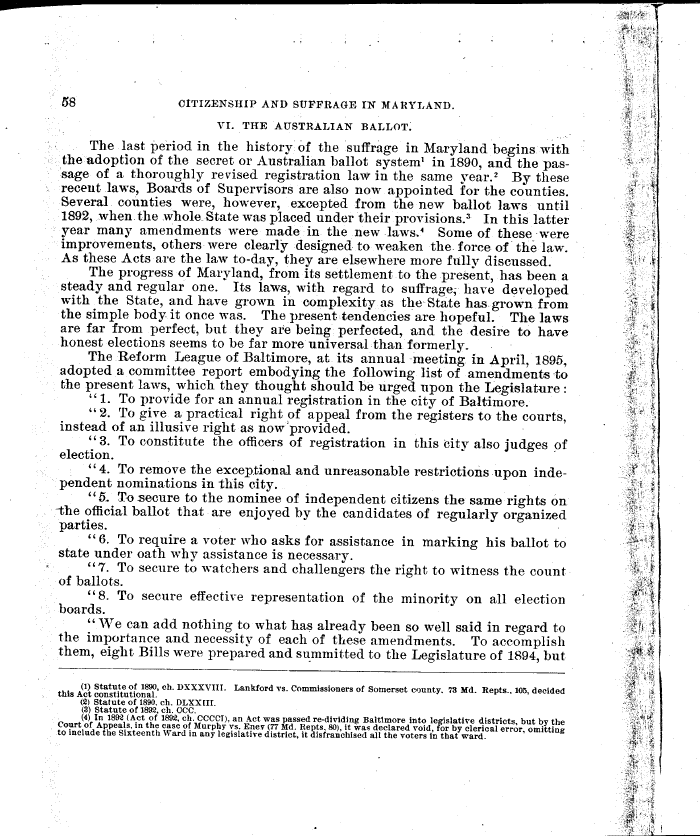|
58 CITIZENSHIP ANTI SUFFRAGE IN MA RYLAND.
VI. THE AUSTRALIAN BALLOT.
The last period in the history of the suffrage in Maryland begins with
the adoption of the secret or Australian ballot system' in 1890, and the
pas-
sage of a thoroughly revised registration law in the same y ea.r.z By these
recent laws, Boards of Supervisors are also now appointed for the counties.
Several counties were, however, excepted from the new ballot laws until
1892, when. the whole- State was placed under their provisions.3 In this
latter
year many amendments were made in the new .laWs.' Some of these -w ere
improvements, others were clearly designed. to weaken the. force of the law
As these Acts are the law to-day, they are elsewhere more fully discussed.
The progress of Maryland, from its settlement to the present, has been a
steady and regular one. Its laws, with regard to suffrage; have developed
with the State, and have grown in complexity as the State has-grown from
the simple body it once was. The present tendencies are hopeful. The laws
are far from perfect, but they are being perfected, and the desire to have
honest elections seems to be far more universal than formerly.
The Reform League of Baltimore, at its annual meeting. in April, 1895,
adapted a committee report embodying the following list of amendments -to
the present laws, which they thought should be urged upon the Legislature
" 1. To provide for an annual registration in the city of Baltimore.
" 2. To give a practical right of appeal from the registers to the courts,
instead of an illusive right as now'provided.
"3. To constitute the officers of registration in this city also judges of
election.
" 4. To remove the exceptional and unreasonable restrictions upon inde-
pendent nominations in this city.
"5_ To secure to the nominee of independent citizens the same rights on
the official ballot that are enjoyed by the candidates of regularly
organized
parties.
" 6. To require a voter who asks for assistance in marking his ballot to
state under oath why assistance is necessary.
"7. To secure to watchers and challengers the right to witness the count
of ballots.
" 8. To secure effective representation of the minority on all election
boards.
" We can add nothing to what has already been so well said in regard to
the importance and necessity of each of these amendments. To accomplish
them, eight Bills were prepared and summitted to the Legislature of 1894,
but
(I) Statute of 1890, ch. DXXXVIII. Lankford vs. Commissioners of Somerset
county, 73 Md. Repts., 105, decided
this Act constitutional.
(2) Statute of 1890, ch. DLXXfII.
(3) Statute of 1892, eh. CCC.
(4) In 1892 (Act of 189;2, ch. CCCCf), an Act was passed re-dividing
Baltimore into legislative districts, but by the
Court of Appeals, in the case of Murphy vs. Enev (77 Aid. Repts, 80), it
was declared void, for by clerical error, omitting
to include the Sixteenth ward in any legislative district, it disfranchised
all the voters in that ward.
|

